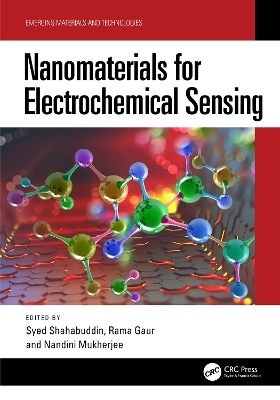
Nanomaterials for Electrochemical Sensing
CRC Press (Verlag)
978-1-032-45888-5 (ISBN)
- Noch nicht erschienen (ca. Mai 2025)
- Versandkostenfrei innerhalb Deutschlands
- Auch auf Rechnung
- Verfügbarkeit in der Filiale vor Ort prüfen
- Artikel merken
This book reviews fundamentals of electrochemical sensors, the preparation of electrodes, potential materials for sensing applications, and different analytical methods used for electrochemical sensing applications. It further covers designing of various electrodes and electrode materials, instruments, sensing mechanism, advanced nanomaterials for sensing, and so forth. The scalability and commercialization of electrochemical sensors and challenges and prospects of electrochemical sensors are also described.
Key Features:
Provides an overview of the advances in application of nanomaterials in sensing
Covers basic fabrication techniques of electrodes as an important part of electrochemical sensors and analysis
Reviews the use and analysis of different types of nanomaterials and nanocomposites used for fabrication of working electrodes
Emphasizes carbon-based nanomaterials, 2D nanomaterials, and advanced nanocomposites comprising various matrix system such as conducting polymers
Explores electron-transfer, redox behavior, fabrication techniques, data interpretation, and advanced nanomaterials as working electrode materials
This book is aimed at researchers and graduate students in nanomaterials, electrochemistry, chemical engineering, and materials science.
Dr. Syed Shahabuddin did his Ph.D. degree in Polymer Chemistry from University of Malaya, Malaysia, in September 2016. Currently, he is working as an assistant professor in Pandit Deendayal Petroleum University, Gandhinagar, and Gujrat. He has published more than 70 research articles in International journals of repute and presented 10 papers in International/National conferences. He is the member of Royal Society of Chemistry (MRSC) and reviewer of many high impact journals. His current research focus on the synthesis of Nanomaterials, 2D-MXene, Graphene, conducting polymer nanocomposites for water treatment, photocatalysis, supercapacitors, DSSCs, nanofluids for solar thermal applications, waste lubricant oil refining and phase change materials. Dr. Rama Gaur is working as an Assistant Professor, School of Technology, PDPU Gandhinagar, Gujarat. She received her Ph.D. degree in Chemistry from IIT Roorkee in 2017. Dr. Gaur has expertise in synthesis of nanoscale materials with interesting and unique morphologies by simple and economical chemical approaches; Shape and size dependent optical, magnetic and electrochemical properties; Applications in photocatalysis, optoelectronics, electrochemical sensing, electrocatalytic reduction/oxidation, solar energy conversion, energy storage devices, supercapacitors, water splitting and environmental remediation Dr. Nandini Mukherjee received her Ph.D. degree in Bioinorganic and Medicinal Chemistry from Indian Institute of Science, Bangalore in 2020. Currently, she is working as an Assistant Professor in the Department of Chemistry, Pandit Deendayal Energy University (PDEU), Gandhinagar, and Gujarat. Prior to joining PDEU she has also worked as a research associate in IISc Bangalore. She has more than 5 years of research experience in organic synthesis and coordination chemistry and published her research in international peer-reviewed journals. Her current research interest focuses on the design and synthesis of molecules that have applications in the field of chemo-sensing of toxins and monitoring biological phenomena.
1.Introduction To Electrochemical Sensors 2. Fabrication Techniques For Electrochemical Sensors 3. Analytical Methods For Electrochemical Sensors 4. Carbon Based Materials For Electrochemical Sensing 5. Metal Oxide Based Materials For Electrochemical Sensing 6. Metal Nanoparticles For Electrochemical Sensing 7. 2D Materials For Electrochemical Sensing 8. Conducting Polymer Based Materials For Electrochemical Sensing 9. Emerging Materials For Biosensing 10. Emerging Materials For Gas Sensing 11. Materials For Sensing Food Contaminants 12. Sensors For Energy Applications 13. Materials For Sensing Explosive Materials 14. Scale-Up, Scalability And Commercialization Of Electrochemical Sensors 15. Challenges And Future Prospects
| Erscheint lt. Verlag | 13.5.2025 |
|---|---|
| Reihe/Serie | Emerging Materials and Technologies |
| Zusatzinfo | 17 Tables, black and white; 71 Line drawings, black and white; 73 Halftones, black and white; 144 Illustrations, black and white |
| Verlagsort | London |
| Sprache | englisch |
| Maße | 178 x 254 mm |
| Themenwelt | Naturwissenschaften ► Chemie ► Physikalische Chemie |
| Technik ► Maschinenbau | |
| ISBN-10 | 1-032-45888-7 / 1032458887 |
| ISBN-13 | 978-1-032-45888-5 / 9781032458885 |
| Zustand | Neuware |
| Informationen gemäß Produktsicherheitsverordnung (GPSR) | |
| Haben Sie eine Frage zum Produkt? |
aus dem Bereich


